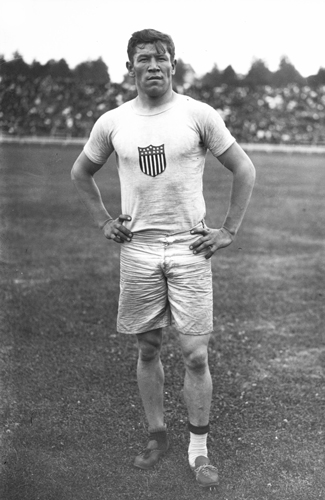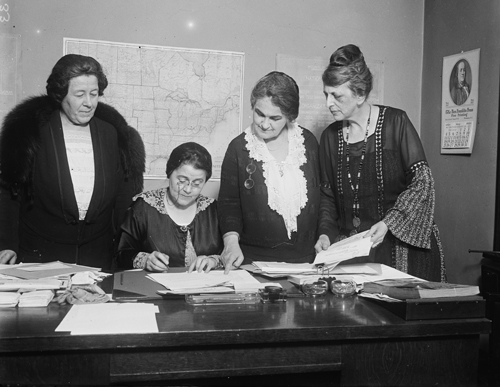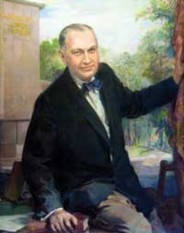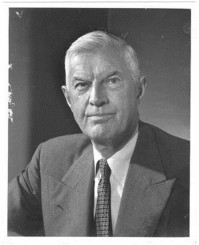
The Oklahoma Century Chest
Biographies
Jim Thorpe

Jim Thorpe at the 1912 Olympics (image courtesy of Wikimedia Commons).
Jim Thorpe, born on May 28, 1888, near the town of Prague, Indian Territory, is arguably the greatest of the twentieth century. Born to Hiram Thorpe and Charlotte Vieux Thorpe, Jim had a twin brother named Charles who died when he was eight. He spent his childhood at various schools: the Sac and Fox Indian Agency School, the Haskell Institute, and finally at the Carlisle Indian School in Pennsylvania.
At Carlisle, Thorpe played football and ran track, both under the famous coach Glenn S. "Pop" Warner. He also met his first wife, Iva Miller, at Carlisle, and they married in 1913. During the summers of 1909 and 1910, Thorpe played baseball in a semiprofessional league in North Carolina. He returned to Carlisle and became a first-team All-American selection in 1911 and 1912. Many sportswriters consider him the best football player of this era.
In 1912, Jim Thorpe competed at the fifth modern Olympic Games. He competed in the high jump and long jump, and won gold medals in the pentathlon and decathlon. His performance at the 1912 Olympics was beyond excellent. He won four events and placed in the top ten in two others, a feat that no athlete has since equaled. Controversy followed Thorpe home, though. In January of 1913, a news story broke detailing his participation in semiprofessional baseball during 1909 and 1910. According to the Olympic rules of the day, this disqualified him from amateur status and participation in the Olympics. The International Olympic Committee stripped Thorpe of his medals and struck his record-setting performance from the books.
Jim Thorpe did not let this stop him. In 1913 he joined the New York Giants as an outfielder and played Major League Baseball until 1919. At the same time, from 1915 to 1928, Thorpe played football; first, for the Canton Bulldogs, and then for teams in Cleveland, Rock Island, and New York. In 1920, he became the first president of the National Football League. For two years, in 1927 and 1928, there is also evidence that Jim Thorpe played professional basketball on a traveling all-American Indian team.
Jim Thorpe eventually retired from sports and traveled to Hollywood to act in film. He was an actor in at least seventy films, mostly as an extra. By the end of his life, Thorpe had been married three times and had seven children. He was a world-record track star; a professional football, baseball, and basketball player; and a Hollywood actor. Jim Thorpe passed away from heart failure in 1953, but his story doesn't end there. In 1982, the International Olympic Committee reinstated Thorpe's medals, though they did not do the same for his records from those events, so he is listed as co-champion of the decathlon in 1912 despite having scored 688 more points than the silver medalist. In 1999 and 2000, ESPN and ABC World Sports, respectively, named Jim Thorpe the Athlete of the Century for the twentieth century.
Robert L. Owen

Robert L. Owen, 1907 (18516, W. P. Campbell Collection, OHS).
Robert Latham Owen was born in Lynchburg, Virginia, in 1856. His father was president of a railroad company, and his mother was Cherokee, originally from Indian Territory. Robert attended school in Virginia and Baltimore, eventually receiving a master's degree from Washington and Lee University in 1877. In 1879, his father died unexpectedly, and Robert and his mother returned to Indian Territory. While there, he became the secretary of the Cherokee Board of Education and studied law.
After passing the bar, officials appointed Robert the head of the Union Agency of the Five Tribes. During this time, Owen practiced law and edited the Vinita Indian Chieftain. He argued many of his cases on behalf of the Five Tribes. He argued one of those cases, the "Eastern Cherokee" case, before the US Supreme Court and the decision awarded millions of dollars to members of the Cherokee tribe.
In 1890, Owen established the First National Bank of Muskogee and served as its president until 1900. It was during this time that he witnessed the problems associated with the Panic of 1893, which reinforced his belief in national banking reform. Owen began working with other politicians in Indian Territory on banking reform measures designed to prevent panics in 1896. Owen also worked to create a state for Indian Territory separate from Oklahoma and attended the Sequoyah Convention of 1905 and the Oklahoma Constitutional Convention.
Owen ran for an Oklahoma senate seat after statehood in 1907. He received the most votes out of all the candidates and became one of Oklahoma's first senators as well as one of the nation's first senators of American Indian descent. Senator Owen went on to help create the Senate Banking Committee and served as its first chairperson. Owen also led on issues like child labor reform, women's suffrage, prohibition, and the direct election of senators.
In 1913, Owen helped co-sponsor a bill that became the Federal Reserve Act. Owen sponsored the bill in the Senate, while Congressman Glass from Virginia sponsored the bill in the House. Owen led the debate in the Senate, and the bill was passed on December 18, 1913, by a vote of 54-34.
Owen had many other political victories, including the passage of the Child Labor Law of 1916, but retired in 1925. He remained in Washington, DC, as a lawyer and lobbyist, voicing his opinions on how to stimulate the economy throughout the Great Depression. Robert L. Owen died of surgical complications on July 19, 1947, at the age of 91. He is remembered as a respected and influential politician on a state and national level.
Myrtle Archer McDougal

Myrtle McDougal, standing on the left, with the leaders of the Democratic National Commitee in Washington, DC, in 1924 (image courtesy of the Library of Congress).
In 1913 women did not have a constitutional right to vote, but this did not mean they did not participate in politics. Myrtle Archer McDougal, for example, was a nationally known suffragist. McDougal was born in 1866 to Reverend George Washington and Sarah Jane Archer in Marietta Springs, Mississippi. In 1888, she married Daniel Archibald McDougal. In 1904, the McDougals moved to Sapulpa, Indian Territory, with their three daughters.
While in Sapulpa, Myrtle became interested in working for a constitutional amendment to grant women the right to vote. She joined the Indian Territory Federation of Women's Clubs and served as its president from 1907–1908. After the IFWC joined the Oklahoma Federation of Women's Clubs, she served as its president from 1910–1913. She was primarily concerned with the causes of prohibition, mother's pensions, the living conditions of girls in state custody, and the establishment of scholarships for state university female students.
McDougal's positions included serving as vice-chair of the suffrage campaign in Oklahoma, Honorary Democratic Committee member, and director of the Wilson and Marshall League. She spoke at many events and wrote open letters to newspapers across the nation. She became nationally known as a vocal and well-argued proponent of women's suffrage and was well-liked around the United States.
After the ratification of the nineteenth amendment granted women the right to vote in 1920, McDougal became an officially elected member of the Democratic National Committee and held the position for sixteen years. Myrtle Archer McDougal passed away in 1956, hailed as a "suffragette and crusading leader and organizer whose work in political, literary and women's groups spanned nearly a century."
Monroe Dunaway Anderson and William Lockhart Clayton

Monroe Dunaway Anderson (image courtesy of the MD Anderson Society).

William Lockhart Clayton (image courtesy of the University of North Texas Libraries).
Classen, Overholser, Braniff, Colcord, and Gaylord are just a few of the iconic Oklahoma surnames found in the Book of the City Builders which was deposited in the Oklahoma Century Chest in 1913. In addition to these well-known Oklahoma pioneers, many others who made their mark in America and around the world began their journey in Oklahoma. Two of these early pioneers were Monroe Anderson and William Clayton. In 1904, William Clayton and Frank Anderson established a partnership to engage in the buying and selling of cotton.
They needed more capital and invited their brothers Monroe Anderson and Ben Clayton to become partners in the venture. Thus was established Anderson, Clayton and Company, with its principal office in Oklahoma City. The company prospered for a decade in Oklahoma City and would eventually become the world's largest cotton merchant. In 1916 the company moved its headquarters to Houston to take advantage of the city's recently completed deep-water shipping channel.
By the 1930s Monroe Anderson and William Clayton each owned half of Anderson, Clayton and Company. In 1936, Anderson created a charitable foundation that bears his name and would receive over 19 million dollars after Monroe's death in 1939. The charter of the MD Anderson Foundation did not specify precisely how its money should be used, but the trustees leaned strongly in the direction of health care. Soon after taking possession of the Anderson estate, the trustees and the Texas Legislature authorized the University of Texas to establish a hospital for cancer research and treatment somewhere in the state. The Anderson Foundation agreed to become the primary funding entity of the hospital if it was built in Houston and named for the trust's benefactor. Thus, the preeminent cancer research hospital in the world was born from a legacy that began in Oklahoma City when Anderson, Clayton and Company began operations.
During World War I and World War II William Clayton served on numerous war industries boards and other high-level positions in the United States government. From December 1944 until October 1947 he was assistant and then undersecretary of state for economic affairs, in which capacity he became the principal architect of the European Recovery Program, known commonly as the Marshall Plan. The goal of the Marshall Plan was to rebuild the destroyed communities of Europe and revitalize the Western European economy based on a capitalist model while at the same time holding back the encroachment of Soviet-style communism from dominating Europe.
In 1904, when William Clayton and his sister's husband, Frank Anderson, formed Anderson, Clayton and Company in Oklahoma City he had already been married to his wife Susan Vaughan Clayton for two years. While living and working in Oklahoma City from 1904–1916 the couple built a home which is still located at 425 Northwest 16th Street in Oklahoma City. No other pioneers of Oklahoma City went further on the national or international stage than the Claytons. Mr. Clayton was a successful businessman, civil servant, and philanthropist. Mrs. Clayton was known for her philanthropic work, support for the Fine Arts Museum, women's suffrage movement, and funding of Susan V. Clayton Homes (a low-cost housing project in Houston). In addition, the couple donated their home in Houston to the city to be utilized as a library. The Clayton Library Center is one of the country's preeminent libraries for genealogical research.
In addition to the signatures of the Andersons and Claytons in the Book of the City Builders, the Oklahoma Century Chest contains a small envelope deposited by Mr. and Mrs. Clayton in 1913.

